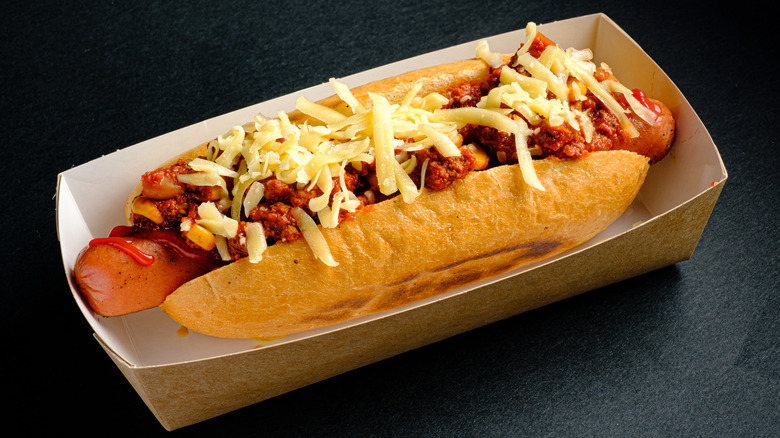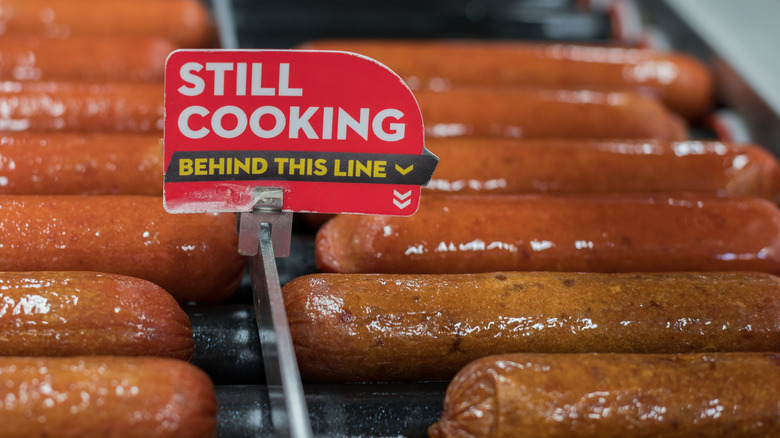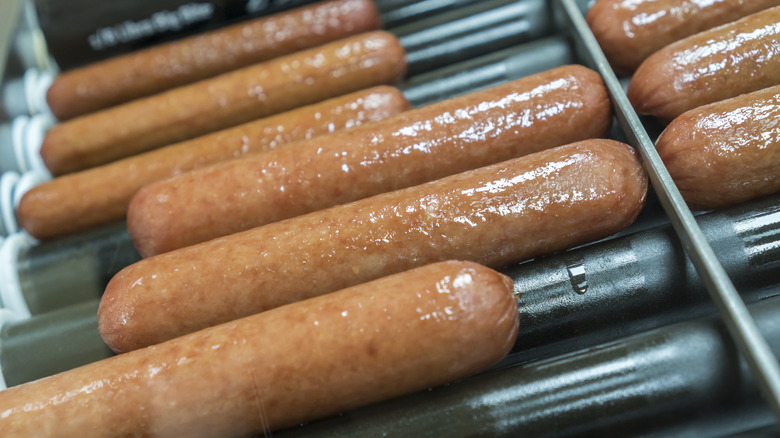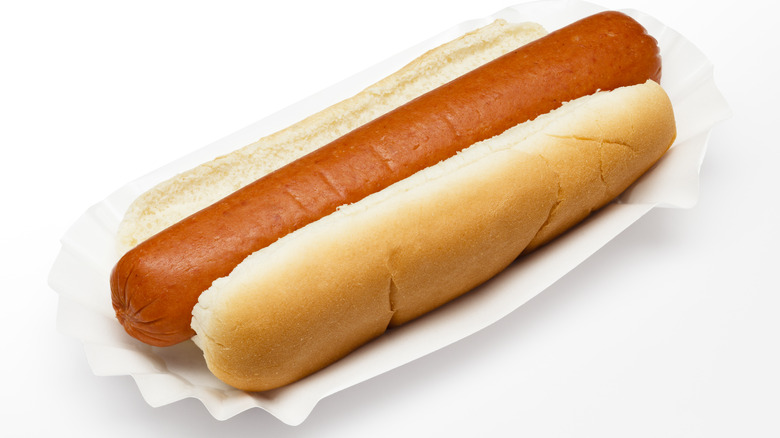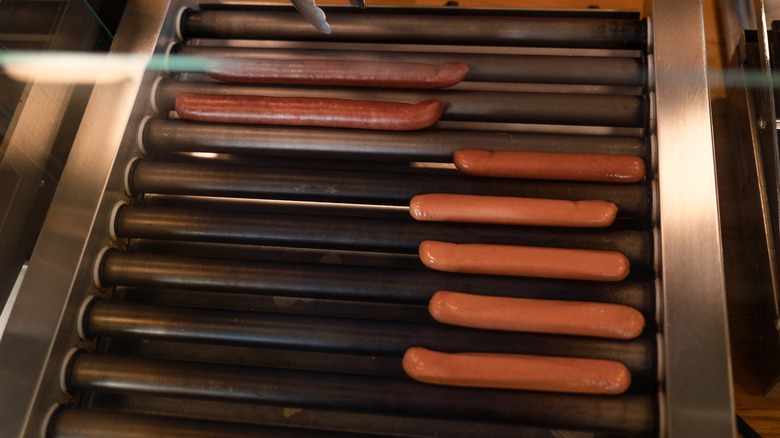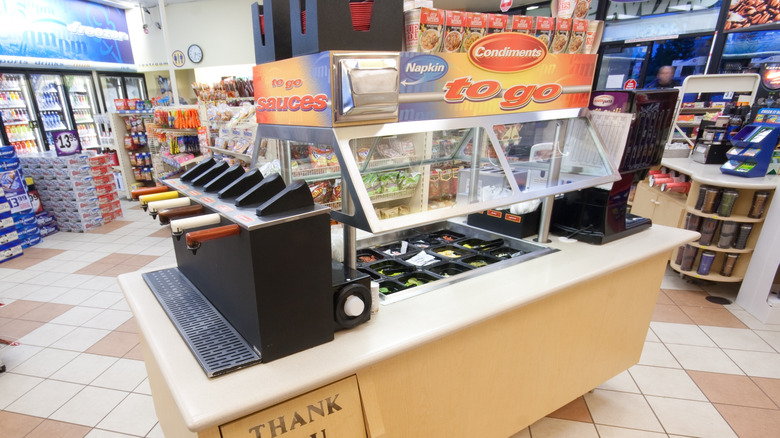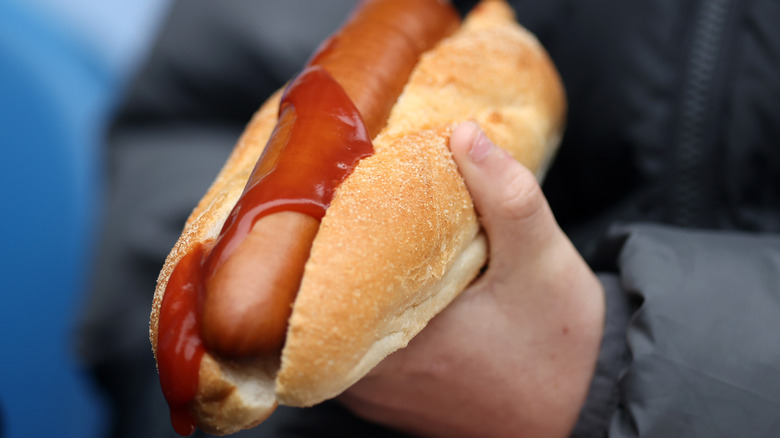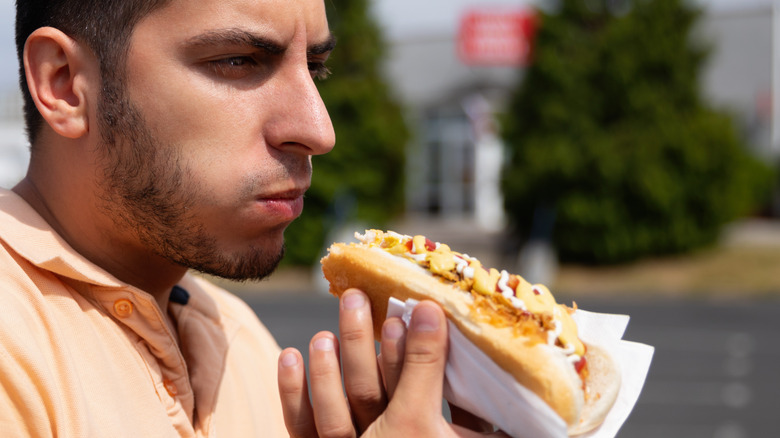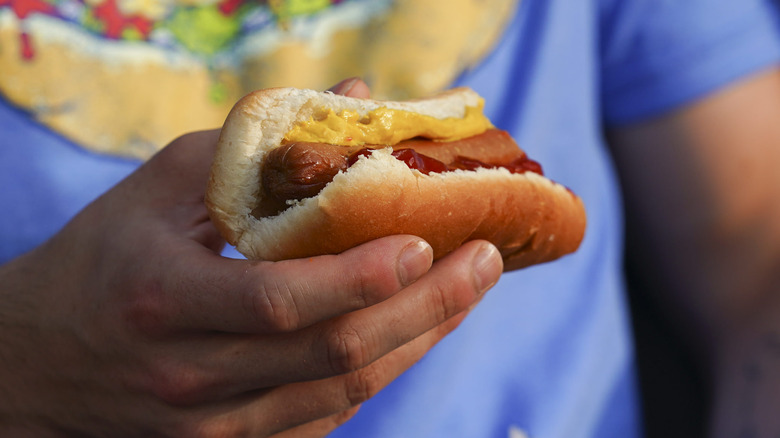Why Gas Station Hot Dogs Taste So Good
The hot dog, as common and ordinary as it may seem to some, might be the most polarizing food in the known world. It's an all-American innovation, a smooth-textured, mild-tasting variation on a standard German sausage that's sold ready-to-eat in countless locations. Yet the preparation of these hot dogs, as well as the outlets where they can be found, vary greatly in terms of credibility and fanciness. While hot dogs are often associated with baseball games, the venue in which they're sold and consumed by far more people every day brings the treat under a shadow. That comes with a reputation tinged with controversy, disdain, and sanctimonious dismissal centered on the humble gas station.
Yes, hot dogs are sold in gas stations. More accurately, they're found in convenience stores usually situated just a few yards away from the fuel pumps. Because of this less-than-traditional and not readily appetizing set-up, hot dogs are widely dismissed as low-class, even disgusting food. But the fact remains: Somebody is happily buying and consuming gas station hot dogs. If they weren't, hot dogs wouldn't be a standard, round-the-clock offering at tens of thousands of filling stations and convenience stores across the U.S.
For all the discredit and animosity that gas station hot dogs may receive, for many they're still immune to criticism. The reason: Gas station hot dogs are undeniably delicious and for myriad reasons. Here's a pointed defense of the humble champion of fast food, the gas station hot dog.
Gas station hot dogs invite nostalgia
Among the many tastes that play on the tongue when you take a bite out of a hot dog — like meat, salt, and fat — is another, harder-to-quantify ingredient that nevertheless winds up flavoring the whole experience. That would be the powerful taste of all: nostalgia.
Hot dogs, in large part because they are economical, portable, and inoffensive to most palates, have been commonly sold or served for more than 100 years. They're typically available at the kinds of public gatherings that people actually want to attend with their favorite people. After all, hot dogs are arguably the unofficial food and the most likely item to be found at events like high school football games, professional sports games, church cookouts, block parties, carnivals, county fairs, and many more events.
Hot dogs are also served in a wide variety of institutional settings, like cafeterias in schools. Because of these settings where nostalgia can color many memories, hot dogs are a widely-pleasing comfort food. Getting one at a gas station can allow those happy and nostalgic feelings to flood the brain. A gas station hot dog in particular may trigger very specific and fondly-recalled memories of road trips where one feasted on hot dogs during past adventures. Those associates could all could very well lead to someone likewise feasting on hot dogs in the present, at their neighborhood gas station.
Simple foods are often the best tasting foods
Despite the lengthy and technical factory-based process that's required to turn meat paste into hot dogs, these treats are, at their core, simple food. A hot dog is essentially just meat and bread, a sandwich that's presented differently, with the processed luncheon meat present as a cylinder that's then placed into the enveloping blanket of a bun. A hot dog is arguably superior to a packaged and chilled gas station sandwich, too. That's because a hot dog is served piping hot.
Sandwiches of all kinds are an equalizer, a populist choice. Nearly everyone likes them and appreciates their simplicity when it comes to delivering balanced and varied nutrition, as well as a meal's worth of calories in a convenient and unfussy manner. Also, like sandwiches, hot dogs are very easy to customize with a variety of different toppings and condiments like mustard, ketchup, and relish. Why add them? To make a tasty food taste even better with very little effort.
The hot dog is decidedly unpretentious, however, and with the exception of the Chicago-style preparation (which typically requires tomatoes, pickles, celery salt, peppers, and more) very few ingredients are involved. Compare that to a more elaborate burger or a meal at a sit-down restaurant, where complication and addition don't always equal better. The hot dog is straightforward and predictable. Sometimes, that absolutely hits the spot. What could be simpler, more efficient, and more reliable than a good gas station hot dog?
Hot dogs and bread just work together
If one doesn't count toppings (and they shouldn't, because there are as many ways to dress a hot dog as there are people who enjoy them), a gas station hot dog consists of just two things: the sizzling frankfurter and a split white bun. Honestly, condiments aren't even necessary to turn this basic meal into something edible and appetizing. For many, the simple combo of a gas station hot dog and its bun are quite enough.
There's something pleasing about the soft texture of the bun, not just its shape or white bread taste, that makes a hot dog taste so much richer and more satisfying than it would on its own. Specifically made for that exact shape and size of frankfurter, a good bun hugs a hot dog in just the right way. It's not so loose that the hot dog falls out during handling or eating, but not so tight that anything gets smashed and ruined. The moisture of the dog doesn't make the bun go instantly soggy, nor does the bun do anything besides offering puffy, slightly gummy bread that holds up a contrast to the slightly spicy, salty, and meaty hot dog. When it comes to taste and texture, hot dogs and buns may be opposites, but opposites attract, after all. In this case, they make for a unique and excellent team.
Low and slow is the way to go
What is it that makes a gas station hot dog so singular, so uniquely different from a ballpark dog or one cooked at home in a stove, oven, microwave, or on a grill? It's the very machinery used to transform a bulk box of raw, cold wieners into hot and ready gas station hot dogs. There's something kind of exciting about those rollers often utilized by filling stations and convenience stores, something that produces a terrific hot dog.
Thanks to those heated rollers, those hot dogs are also cooked at a low temperature for a long time, getting just a little bit toastier until they reach (and are typically kept) an ideal heat. And because they're constantly in motion while turning on the rollers, the end product is cooked all the way through and there should be no burned or overcooked bits. That's something that home cooking methods (or hot dog carts, with their rather questionable water baths) have a hard time delivering.
Because they're heated at a low temperature and cook for so long, gas station hot dogs actually tend to be on the overcooked side. But that's okay, as even this is a hallmark of a gas station dog. They're sizzling, juicy, and pack just the right amount of snap. A hot dog tastes best if all the many ingredients inside can truly intermingle, and it takes patient heating on those rollers for all those boundaries to break down.
The condiment selection at some gas stations can get impressive
Sure, you could (and can) eat a hot dog that you've bought at a gas station totally as-is. We mean one that's served plain, with nothing but that hot dog held inside a fluffy bun. But why would you stop there? Many gas stations and convenience stores offer a surprisingly voluminous array of condiments and toppings, despite the scarcity of real estate inside quite a few of these places. Done right, condiments are what really make a hot dog's flavors come alive and can transform a snack into a balanced meal. Think diced onions, pickle relish, and sauerkraut, for instance, which add a bit of nutrition to what's admittedly an otherwise vitamin-scarce meal.
The gas station wants you to use that condiment bar. It's provided pump containers and packets of the most commonly-favored toppings, and not just for hot dogs, but for all of the other hot fare it may sell. With a little creativity in mind, this allows you an opportunity to try something new and even a little adventurous on a hot dog. For instance, the hot sauce intended for a burrito could be your new favorite hot dog condiment. The sliced pickles meant to enliven the microwaveable cheeseburgers could add some nice sourness to a hot dog. With an open mind and the right condiment bar, the possibilities are nearly endless.
A gas station hot dog can be a specialty hot dog
At its core, a gas station hot dog is simple, understated, and just fine with the addition of a few pumps of ketchup or a zig-zag of mustard. But it doesn't have to be something you can eat with one hand while operating a steering wheel with the other. Gas station hot dogs are a blank slate that can be turned into a robust and messy meal with the resources presented by the seller — and free of charge, to boot.
In addition to the common hot dog sauces like ketchup, mustard, and mayonnaise, gas stations and convenience store condiment stations might also allow for all-you-want sliced produce like pickles, tomatoes, and onions. You can even transform that hot dog into the regionally popular, internationally-known Chicago-style hot dog. While a poppy seed bun and celery salt aren't necessarily forthcoming at a gas station, other elements — like mustard, onions, relish, tomatoes, peppers, and dill pickles — probably are. One can also use the hot chili and spicy molten cheese, likely present for gas station nachos, and make themselves a chili cheese dog.
Customization and choice are key when it comes to gas station hot dogs. That's why it's such a welcome and appetizing sight when gas stations offer multiple hot dog options like spicy franks and extra-large ones, the just of which are perhaps best suited to handle all those toppings.
Gas station hot dogs are delightfully cheap
Long before hamburger chains like White Castle and McDonald's came on the scene, street vendors in cities sold fully-cooked franks on rolls as early as the 1870s. The street hot dog trade established a lot of the fast food tropes that continue to this day: The carts were ubiquitous, the offerings were broadly palatable, they didn't take much time to purchase or consume, and, perhaps most importantly of all, they were cheap.
Maybe a gas station hot dog tastes so good, at least in part, because it is so cheap. Scarfing down one (or two, or three) is a calorically dense affair, for one. It's a full meal with at least two of the major food groups (protein and carbohydrate) covered for a relatively light hit on your wallet. Another box can be checked if you count gas station-provided condiments like pickle relish, sliced onions, or sauerkraut as fruits and vegetables.
All that energy — or at least a very full stomach — comes at a low cost. Hot dogs are always going to be fairly inexpensive, particularly at gas stations. They're made from low-cost elements (namely, mass-produced, processed meats and white bread buns) and it's in the gas station company's best interests to keep them cheap and accessible. It doesn't cost producers or station owners much in terms of ingredients or shelf space to keep hot dogs around, so they can theoretically pass the savings on to their hungry customers.
They're made with lots of what we naturally crave
Many cravings boil down to a deep physiological and seemingly immediate need for one of the most basic elements of food: salt, fat, or carbohydrates. It's positively primal how when we want something fatty, salty, or starchy, many of us simply can't think of anything else and won't rest until we get that need met. The gas station hot dog could be considered the most crave-worthy all-in-one food, especially since it's readily available and fully cooked just down the street at a local gas station.
When the food one unabashedly needs is loaded with an amount of fat, salt, or sugar that may exceed nutritional recommendations, a gas station hot dog is the way to go. Because the wieners predominantly found in gas station hot dogs are cheaper, low-quality ones, they're going to pack in quite a lot of salt and fat. They're inexpensive fillers that can replace the more costly actual meat found in highbrow 100% all-beef hot dogs you might find at restaurants or the grocery store. The simple carbohydrates that make up the bulk of the white bread bun are full of sugar, too, so that craving can be addressed at the same time.
It's likewise tough not to give in to the allure of a food smell. Like movie theater popcorn or fried foods at a fair, the smoky, meaty smell of gas station hot dogs cooking on those rollers is tough to resist.
The unhealthy stuff is what makes it taste so good
In addition to salt, fat, and carbs, the elements of a hot dog we crave the most — and which taste the best and make a hot dog what it is — are the very things our bodies don't actually need on a biological level. Hot dogs — and gas station hot dogs in particular — are full of not-so-healthy ingredients like nitrites and nitrates, chemical salts that are added to hot dogs and other cured meats as preservatives. Sodium or potassium nitrite helps the ingredients settle into the hot dog mixture and stay that way for a while, ensuring a lengthy shelf life. However, they are also strongly associated with the smell and unique flavor of processed meats, including those gas station hot dogs. That combination of slight smokiness, a hint of spice, and abundant fatty pork or concentrated beef taste is pronounced and elevated because of nitrites.
All told, these additives, whether they are of natural or synthetic origin, are what make a hot dog taste like a hot dog. When we want to eat a gas station hot dog, the taste of these foodstuffs is what we're truly after. Our rational brains may tell us to avoid nitrates, given that overconsumption of them could lead to type 2 diabetes (per Metabolism) or even cancer (per Antioxidants), but that doesn't make the occasional hot dog any less appealing to the taste buds.
Gas station hot dogs are relatively rare
Hot dogs may be common, but when it comes to the wider fast food landscape, they're actually quite rare. In North America, quick food and road food is synonymous with hamburgers, French fries, and boneless, breaded fried chicken. Almost none of the big fast food chains — think places like McDonald's, Burger King, and Wendy's — serve hot dogs regularly, if at all. People who obtain a lot of their meals at gas stations are also people who likely spend a lot of time in their cars and are more often subject to drive-thru fare. With those other options in mind, a hot dog could be a refreshing and stark alternative. Consider how one is made of minced beef and pork, not ground beef, while the sides available at a gas station go beyond the ubiquitous French fries.
A hot dog is also a potentially lighter choice than a giant burger or chicken sandwich. It's also scalable — if one hot dog isn't enough to satisfy your appetite, then another is right there for the taking.
